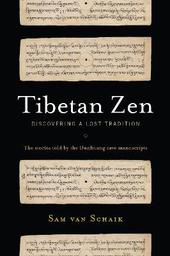
|
Tibetan Zen: Discovering a Lost Tradition
Paperback / softback
Main Details
| Title |
Tibetan Zen: Discovering a Lost Tradition
|
| Authors and Contributors |
By (author) Sam van Schaik
|
| Physical Properties |
| Format:Paperback / softback | | Pages:176 | | Dimensions(mm): Height 229,Width 152 |
|
| Category/Genre | Zen Buddhism |
|---|
| ISBN/Barcode |
9781559394468
|
| Classifications | Dewey:294.3927 |
|---|
| Audience | |
|---|
|
Publishing Details |
| Publisher |
Shambhala Publications Inc
|
| Imprint |
Snow Lion Publications
|
| Publication Date |
25 August 2015 |
| Publication Country |
United States
|
Description
A groundbreaking study of the lost tradition of Tibetan Zen containing the first translations of key texts from one thousand years ago. Banned in Tibet, forgotten in China, the Tibetan tradition of Zen was almost completely lost to us. According to Tibetan histories, Zen teachers were invited to Tibet from China in the 8th century, at the height of the Tibetan Empire. When doctrinal disagreements developed between Indian and Chinese Buddhists at the Tibetan court, the Tibetan emperor called for a formal debate. When the debate resulted in a decisive win by the Indian side, the Zen teachers were sent back to China, and Zen was gradually forgotten in Tibet. This picture changed at the beginning of the 20th century with the discovery in Dunhuang (in Chinese Central Asia) of a sealed cave full of manuscripts in various languages dating from the first millennium CE. The Tibetan manuscripts, dating from the 9th and 10th centuries, are the earliest surviving examples of Tibetan Buddhism. Among them are around 40 manuscripts containing original Tibetan Zen teachings. This book translates the key texts of Tibetan Zen preserved in Dunhuang. The book is divided into ten sections, each containing a translation of a Zen text illuminating a different aspect of the tradition, with brief introductions discussing the roles of ritual, debate, lineage, and meditation in the early Zen tradition. Van Schaik not only presents the texts but also explains how they were embedded in actual practices by those who used them.
Author Biography
SAM VAN SCHAIK received his PhD in Tibetan Buddhist literature from the University of Manchester, England. He currently works at the British Library's international Dunhuang Project in London, researching early Tibetan manuscripts, and is the author of Tibet- A History (Yale, 2011).
Reviews"Tibetan Zen is an unprecedented work. Van Schaik's explanations expand our notion of just what Tibetan Buddhism was-and is-while his translations offer contemporary readers the opportunity to expand their own minds by engaging classic Zen writings from a deeply creative period of Buddhism."-Kurtis R. Schaeffer, University of Virginia "The Chinese character Zen ( ) has two parts that mean 'symbolize the single' or 'inseparable meaning,' while the great Kagyu master Phagmodrupa says nonduality is Mahamudra. Therefore, there is no essential difference between Zen, Mahamudra, and Dzogchen teachings."-His Holiness the Drikung Kyabgon Chetsang, author of The Practice of Mahamudra "This selection of some core texts of Tibetan Zen provides us with another map through the mysteries of our human hearts and minds and helps us walk our own way to realization. How wonderful!"-James Ishmael Ford, author of Zen Master Who? "In this beautifully written book, Sam van Schaik guides his reader into a lost world, bringing the Dunhuang manuscripts to life through his careful analyses. The result is a comprehensive presentation of an extinct and in many ways unique Buddhist tradition, a study whose brilliant insights into early esoteric ritual, the bodhisattva precepts, and much more shed light on the origins of both Tibetan Buddhism and Chinese Chan/Zen.-Jacob P. Dalton, author of The Taming of the Demons
|